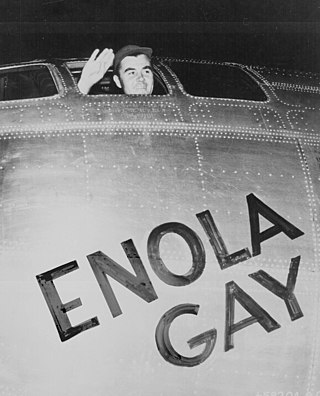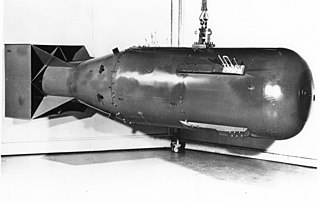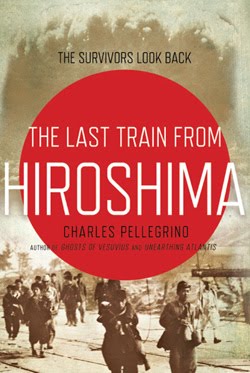
The Enola Gay is a Boeing B-29 Superfortress bomber, named after Enola Gay Tibbets, the mother of the pilot, Colonel Paul Tibbets. On 6 August 1945, during the final stages of World War II, it became the first aircraft to drop an atomic bomb in warfare. The bomb, code-named "Little Boy", was targeted at the city of Hiroshima, Japan, and destroyed about three-quarters of the city. Enola Gay participated in the second nuclear attack as the weather reconnaissance aircraft for the primary target of Kokura. Clouds and drifting smoke resulted in Nagasaki, a secondary target, being bombed instead.

Little Boy was a type of atomic bomb created by the United States as part of the Manhattan Project during World War II. The name is also often used to describe the specific bomb (L-11) used in the bombing of the Japanese city of Hiroshima by the Boeing B-29 Superfortress Enola Gay on 6 August 1945, making it the first nuclear weapon used in warfare, and the second nuclear explosion in history, after the Trinity nuclear test. It exploded with an energy of approximately 15 kilotons of TNT (63 TJ) and had an explosion radius of approximately 1.3 kilometres (0.81 mi) which caused widespread death across the city. It was a gun-type fission weapon which used uranium that had been enriched in the isotope uranium-235 to power its explosive reaction.

Nagasaki, officially known as Nagasaki City, is the capital and the largest city of the Nagasaki Prefecture on the island of Kyushu in Japan.

Charles William Sweeney was an officer in the United States Army Air Forces during World War II and the pilot who flew Bockscar carrying the Fat Man atomic bomb to the Japanese city of Nagasaki on 9 August 1945. Separating from active duty at the end of World War II, he later became an officer in the Massachusetts Air National Guard as the Army Air Forces transitioned to an independent United States Air Force, eventually rising to the rank of major general.

Hibakusha is a word of Japanese origin generally designating the people affected by the atomic bombings of Hiroshima and Nagasaki by the United States at the end of World War II.

Yoshito Matsushige was a Japanese photojournalist who survived the dropping of the atomic bomb on the city of Hiroshima on 6 August 1945 and took five photographs on the day of the bombing in Hiroshima, the only photographs taken that day within Hiroshima that are known.

Nagasaki Peace Park is a park located in Nagasaki, Japan, commemorating the atomic bombing of the city on August 9, 1945 during World War II. It is next to the Atomic Bomb Museum and near the Peace Memorial Hall.

The Hiroshima Peace Memorial Museum is a museum located in Hiroshima Peace Memorial Park, in central Hiroshima, Japan, dedicated to documenting the atomic bombing of Hiroshima in World War II.

Ryuichi Shimoda et al. v. The State was an unsuccessful case brought before the District Court of Tokyo by a group of five survivors of the atomic attacks on Hiroshima and Nagasaki, who claimed the action was illegal under the laws of war and demanded reparations from the Japanese government on the ground that it waived the right for reparations from the U.S. government under the 1951 Treaty of San Francisco.

The Nagasaki Atomic Bomb Museum is in the city of Nagasaki, Japan. The museum is a remembrance to the atomic bombing of Nagasaki by the United States on 9 August 1945 at 11:02:35 am. Next to the museum is the Nagasaki National Peace Memorial Hall for the Atomic Bomb Victims, built in 2003. The bombing marked a new era in war, making Nagasaki a symbolic location for a memorial. The counterpart in Hiroshima is the Hiroshima Peace Memorial Museum. These locations symbolize the nuclear age, remind visitors of the vast destruction and indiscriminate death caused by nuclear weapons, and signify a commitment to peace.

Jacob Beser was a lieutenant in the United States Army Air Forces who served during World War II. Beser was the radar specialist aboard the Enola Gay on August 6, 1945, when it dropped the Little Boy atomic bomb on Hiroshima. Three days later, Beser was a crewmember aboard Bockscar when the Fat Man bomb was dropped on Nagasaki. He was the only person to have served as a strike crew member of both of the 1945 atomic bomb missions.

On 6 and 9 August 1945, the United States detonated two atomic bombs over the Japanese cities of Hiroshima and Nagasaki, respectively. The bombings killed between 150,000 and 246,000 people, most of whom were civilians, and remain the only use of nuclear weapons in an armed conflict. Japan surrendered to the Allies on 15 August, six days after the bombing of Nagasaki and the Soviet Union's declaration of war against Japan and invasion of Japanese-occupied Manchuria. The Japanese government signed the instrument of surrender on 2 September, effectively ending the war.

The Atomic Bomb Casualty Commission (ABCC) was a commission established in 1946 in accordance with a presidential directive from Harry S. Truman to the National Academy of Sciences-National Research Council to conduct investigations of the late effects of radiation among the atomic-bomb survivors in Hiroshima and Nagasaki. As it was erected purely for scientific research and study, not as a provider of medical care and also because it was heavily supported by the United States, the ABCC was generally mistrusted by most survivors and Japanese alike. It operated for nearly thirty years before its dissolution in 1975.

Substantial debate exists over the ethical, legal, and military aspects of the atomic bombings of Hiroshima and Nagasaki on 6 August and 9 August 1945 respectively at the close of the Pacific War theater of World War II (1939–45).
The Atom Strikes is a documentary commissioned by the U.S. Army Signal Corps Pictorial Division shortly after the end of the Second World War. It documents the findings of a commission sent to Japan to assess the damage caused by the atomic bombing of Hiroshima and Nagasaki.
First Into Nagasaki: The Censored Eyewitness Dispatches on Post-Atomic Japan and Its Prisoners of War is a collection of reports by Chicago Daily News foreign correspondent George Weller. Originally written in 1945, but not approved for publication by Gen. Douglas MacArthur's military censors. The reports were collected and edited by the author's son Anthony Weller, and published for the first time in 2006.

The Last Train From Hiroshima: The Survivors Look Back and its revised second edition To Hell and Back: The Last Train From Hiroshima is a book by American author Charles R. Pellegrino and published on January 19, 2010 by Henry Holt and Company that documents life in Hiroshima and Nagasaki in the time immediately preceding, during and following the aftermath of the atomic bombings of Japan. The story focuses on individuals such as Tsutomu Yamaguchi, a hibakusha who was the only person confirmed by the government of Japan to have survived the pika-don (flash-bang) of both attacks. The story of the impacts in Japan on the residents of the two targeted cities and of the response of the Japanese government to the attack is interwoven with details of the Americans who carried out the missions and their reactions to the damage they had wrought.

The Bomb is a 2015 American documentary film about the history of nuclear weapons, from theoretical scientific considerations at the very beginning, to their first use on August 6, 1945, to their global political implications in the present day. The film was written and directed by Rushmore DeNooyer for PBS. The project took a year and a half to complete, since much of the film footage and images were only recently declassified by the United States Department of Defense.

Hiroshima (ひろしま) is a 1953 Japanese docudrama film directed by Hideo Sekigawa about the atomic bombing of Hiroshima and its impact on a group of teachers, their students, and their families. The film was based on the eye-witness accounts of the hibakusha children compiled by Dr. Arata Osada for the 1951 best-selling book Children Of The A Bomb: Testament Of The Boys And Girls Of Hiroshima, and was filmed with the support of tens of thousands of Hiroshima residents.
















